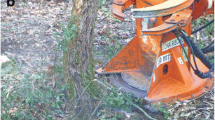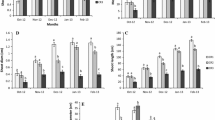Abstract
The adventitious rooting of mini-cuttings with less time spent in the greenhouse is a desired step in plant production in forestry companies. This can minimize costs due to the better use of the facilities, avoiding the permanence of plants beyond the necessary time or the death of mini-cuttings due to the removal of the greenhouse before the rhizogenic process is completed. The objective of this work was to evaluate the survival analysis techniques in the mini-cutting rooting of forest species and determine the optimal time of the greenhouse. The experimental design used was completely randomized in a split-plot scheme. The plots consisted of the species, Cariniana estrellensis, Cariniana legalis, Cordia alliodora, and Cordia trichotoma, and the subplots corresponded to the substrates: organic pine bark compost—OPBC, carbonized rice husk—CRH, and fine Vermiculite—FV. The survival and hazard functions of mini-cutting rooting, the Kaplan–Meier estimator, the Log-Rank, and Wilcoxon tests were estimated. It is concluded that the survival analysis techniques effectively discriminate the rooting of species in different substrates over time in the greenhouse. The optimum time in the greenhouse, the point on the curve at which rooting becomes constant, in this study, was 40, 49, and 49 days for Cordia alliodora; 47, 46, and 49 for Cariniana legalis; 47, 48, and 47 for Cariniana estrellensis and 51, 50, and 47 for Cordia trichotoma, in substrates S1-100% OPBC, S2—33% OPBC + 33.5% CRH + 33.5% FV and S3—50% CRH + 50% FV, respectively.



Similar content being viewed by others
References
Almeida RS, Almeida DB, Faria JCT, Melo LA, Stehling EC, Vilela ES (2020) Efeito na indução do enraizamento em função da forma e ao tempo de preparo das miniestacas de Toona ciliata e híbridos de Eucalyptus grandis x Eucalyptus urophylla. Sci for 48(127):e3089. https://doi.org/10.18671/scifor.v48n127.09
Araújo EF, Gibson EL, Santos AR, Gonçalves EO, Wendling I, Alexandre RS, Pola LAV (2019) Mini-cutting technique for vegetative propagation of Paratecoma peroba. Cerne 25(3):314–325. https://doi.org/10.1590/01047760201925032647
Baul TK, Mezbahuddin M, Hossain MM, Mohiuddin M (2010) Vegetative propagation of Holarrhena pubescens, a wild tropical medicinal plant: effect of indole-3-butyric acid (IBA) on stem cuttings. For Stud China 12(4):228–235. https://doi.org/10.1007/s11632-010-0409-3
Brondani GE, Wendling I, Brondani AE, Araujo MA, Silva ALL, Gonçalves AN (2012) Dynamics of adventitious rooting in mini-cuttings of Eucalyptus benthamii x Eucalyptus dunnii. Acta Sci Agron 34(2):169–178. https://doi.org/10.4025/actasciagron.v34i2.13059
Caldeira MVW, Delarmelin WM, Faria JCT, Juvanhol RS (2013) Substratos alternativos na produção de mudas de Chamaecrista desvauxii. Rev Árvore 37:31–39. https://doi.org/10.1590/S0100-67622013000100004
Carvalho PER (2010) Espécies arbóreas brasileiras. Embrapa Florestas, Brasília, DF
Colosimo EA, Giolo SR (2006) Análise de sobrevivência aplicada. Editora Blücher, São Paulo
Dias PC, Xavier A, Oliveira LS, Correia ACG, Barbosa GA (2015) Tipo de miniestaca e de substrato na propagação vegetativa de angico-vermelho (Anadenanthera macrocarpa (Benth.) Brenan). Ciênc Florest 25(4):909–919. https://doi.org/10.5902/1980509820593
Ferreira EM, Alfenas AC, Mafia RG, Leite HG, Sartorio RC, Filho RMP (2004) Determinação do tempo ótimo do enraizamento de miniestacas de clones de Eucalyptus spp. Rev Árvore 28(2):183–187. https://doi.org/10.1590/S0100-67622004000200004
Fragoso RO, Stuepp CA, Carpanezzi AA, Wendling I, Zuffellato KCR, Soares HK (2020) Ficus enormis cuttings rooting: concentrations of indole butyric acid and seasonal variations. Bosque (valdivia) 41(3):373–379. https://doi.org/10.4067/S0717-92002020000300373
Freitas AF, Paiva HN, Xavier A, Neves JCL (2017) Produtividade de minicepas e enraizamento de miniestacas de híbridos de Eucalyptus globulus LABILL. em resposta a nitrogênio. Ciênc Florest 27(1):193–202. https://doi.org/10.5902/1980509826458
Gehan E (1965) A generalized Wilcoxon test for comparing arbitrarily singly-censored samples. Biometrika 52:203–223. https://doi.org/10.2307/2333825
Gibson EL, Gonçalves EO, Santos AR, Araújo EF, Wendling I, Alexandre RS, Caldeira MVW (2021) Responsiveness of Melanoxylon brauna to mini-cuttings technique. Rhizosphere 17:100303. https://doi.org/10.1016/j.rhisph.2020.100303
Hartmann HT, Kester DE, Davies FT Jr, Geneve RL (2011) Plant propagation: principles and practices, 8th edn. Prentice Hall, New Jersey
IBGE (2021) Instituto Brasileiro de Geografia e Estatística. Diretoria de Pesquisas, Coordenação de Estatísticas Agropecuárias. Produção da Extração Vegetal e da Silvicultura 2021. Rio de Janeiro, vol 36, pp 1–8. https://biblioteca.ibge.gov.br/visualizacao/periodicos/74/pevs_2021_v36_informativo.pdf. Accessed 11 November 2022
Jannat M, Hossain MK, Alam MS, Hossain MA, Kamruzzaman M (2017) Vegetative propagation of Tali (Palaquium polyanthum Engl.) for commercial harvest and landscape conservation. Rhizosphere 3:9–12. https://doi.org/10.1016/j.rhisph.2016.11.003
Kaplan EL, Meier P (1958) Nonparametric estimation from incomplete observation. J Am Stat Assoc 53:457–481. https://doi.org/10.1007/978-1-4612-4380-9_25
Kitikidou K, Apostolopoulou E (2011) Applying survival analysis for assessment of forests sustainable development. Renew Sustain Energy Rev 15(1):851–855. https://doi.org/10.1016/j.rser.2010.08.008
Kratz D, Pires PP, Stuepp CA, Wendling I (2015) Produção de mudas de erva-mate por miniestaquia em substratos renováveis. Rev Floresta 45:609–616. https://doi.org/10.5380/rf.v45i3.36531
Lorenzi H (2020) Árvores brasileiras: manual de identificação e cultivo de plantas arbóreas nativas do Brasil, 8th edn. Editora Plantarum, Nova Odessa
Manso R, Fortin M, Calama R, Pardos M (2013) Modelling seed germination in forest tree species through survival analysis. The Pinus pinea L. case study. For Ecol Manag 289:515–524. https://doi.org/10.1016/j.foreco.2012.10.028
Mantel N (1966) Evaluation of survival data and two new rank order statistics arising in its consideration. Cancer Chemother Rep 50:163–170
Melo LA, Xavier A, Paiva HN, Borges SR (2011) Otimização do tempo necessário para o enraizamento de miniestacas de clones híbridos de Eucalyptus grandis. Rev Árvore 35(4):759–767. https://doi.org/10.1590/S0100-67622011000500001
Moura L, Titon M, Moura CC, Souza CC, Santana RC (2019) Ácido indolbutírico (AIB) e substratos na propagação vegetativa de Jatobá (Hymenaea courbaril L.) por miniestaquia. Adv for Sci, Cuiabá 6(1):515–522. https://doi.org/10.34062/afs.v6i1.6434
Neres YXC, Azevedo GTOS, Souza AM, Azevedo GB, Teodoro PE (2019) Effect of the hydrogel incorporation on different substrates on the rooting and quality of clonal Eucalyptus seedlings. Sci for, Piracicaba 47(122):336–345. https://doi.org/10.18671/scifor.v47n122.16
Pereira MO, Navroski MC, Ângelo AC, Schafer G, Andrade RS, Moraes C, Souza G (2021) Enraizamento de Sequoia sempervirens (Cupressaceae) em função do padrão de miniestacas, substratos e regulador de crescimento. Ciênc Florest 31(3):1258–1277. https://doi.org/10.5902/1980509836857
Pessanha SEGL, Barroso DG, Barros TC, Oliveira TPF, Carvalho GCMW, Cunha M (2018) Limitações na produção de vinhático (Plathymenia reticulata Benth) por miniestaquia. Ciênc Florest 28(4):1688–1703. https://doi.org/10.5902/1980509835317
R Core Team (2022) R: a language and environment for statistical computing. R Foundation for Statistical Computing, Vienna, Austria. Available from: https://www.R-project.org/
Santos AR, Gonçalves EO, Gibson EL, Araújo EF, Wendling I, Tertuliano LA, Caldeira MVW (2020) Mini-cuttings technique for vegetative propagation of Dalbergia nigra. Cerne 26(4):427–434. https://doi.org/10.1590/01047760202026042749
Silva RBG, Simões D, Silva MR (2012) Qualidade de mudas clonais de Eucalyptus urophylla x E. grandis em função do substrato. Rev Bras Eng Agrícola Ambient 16:297–302. https://doi.org/10.1590/S1415-43662012000300010
Stuepp CA, Wendling I, Koehler HS, Zuffellato-Ribas KC (2016) Quality of clonal plants of Piptocarpha angustifolia in different renewable substrates and seasons of the year. Pesq Agropecu Bras 51(11):1821–1829. https://doi.org/10.1590/S0100-204X2016001100004
Stuepp CA, Fragoso RO, Monteiro PHR, Kratz D, Wendling I, Zuffellato-Ribas KC (2017) Use of renewable substrates for ex vitro production of Melaleuca alternifolia Cheel clonal plants by mini-cuttings technique. Cerne 23(4):395–402. https://doi.org/10.1590/01047760201723042434
Therneau T (2022) A package for survival analysis in R. R package version 3.4-0. Available from: https://CRAN.R-project.org/package=survival
Tremblay PO, Duchesne T, Cumming SG (2018) Survival analysis and classification methods for forest fire size. PLoS ONE 13(1):e0189860. https://doi.org/10.1371/journal.pone.0189860
Uzoh FCC, Mori SR (2012) Applying survival analysis to managed even-aged stands of ponderosa pine for assessment of tree mortality in the western United States. For Ecol Manag 285:101–122. https://doi.org/10.1016/j.foreco.2012.08.006
Wijenayake PR, Hiroshima T (2021a) Prediction of tree age distribution based on survival analysis in natural forests: a case study of preserved permanent plots in the University of Tokyo Hokkaido Forest, northern Japan. Environ Sci Proc 3:50. https://doi.org/10.3390/IECF2020-08077
Wijenayake PR, Hiroshima T (2021b) Age-based survival analysis of coniferous and broad-leaved trees: a case study of preserved forests in northern Japan. Forests 12:1014. https://doi.org/10.3390/f12081014
Xavier A, Wendling I, Silva RL (2021) Silvicultura clonal: princípios e técnicas, 3rd edn. Universidade Federal de Viçosa, MG, Brazil
Acknowledgements
The authors express their sincere thanks to the Research Support Foundation of the State of Minas Gerais (FAPEMIG) and National Council for Scientific and Technological Development (CNPq) for the financial support and the reviewers and editors for their suggestions.
Author information
Authors and Affiliations
Contributions
MLD: Conceptualization, Methodology, Formal analysis, Data Curation, Visualization, Writing—original draft. SMF: Conceptualization, Methodology, Formal analysis, Writing—original draft. AFF: Investigation, Resources, Writing—review & editing. AX: Investigation, Supervision, Writing—review & editing. All authors read and approved the final manuscript.
Corresponding author
Ethics declarations
Conflict of interest
The authors declare that they have no known competing financial interests or personal relationships that could have appeared to influence the work reported in this paper.
Additional information
Publisher’s Note
Springer Nature remains neutral with regard to jurisdictional claims in published maps and institutional affiliations.
Rights and permissions
Springer Nature or its licensor (e.g. a society or other partner) holds exclusive rights to this article under a publishing agreement with the author(s) or other rightsholder(s); author self-archiving of the accepted manuscript version of this article is solely governed by the terms of such publishing agreement and applicable law.
About this article
Cite this article
Duarte, M.L., Martins Filho, S., de Freitas, A.F. et al. Rooting of forest species mini-cuttings: an application of non-parametric survival analysis. New Forests 54, 1153–1167 (2023). https://doi.org/10.1007/s11056-023-09962-0
Received:
Accepted:
Published:
Issue Date:
DOI: https://doi.org/10.1007/s11056-023-09962-0




